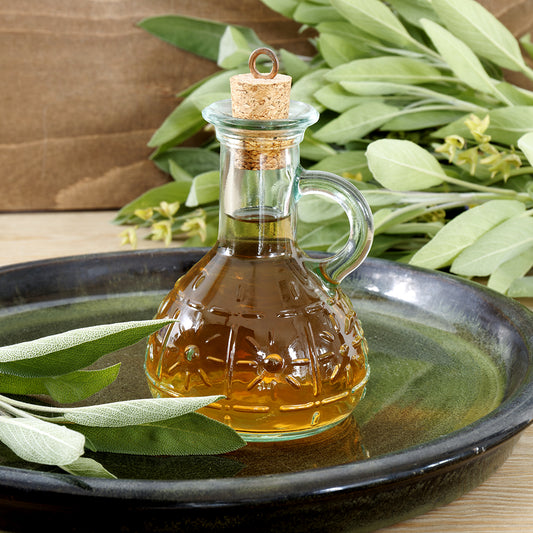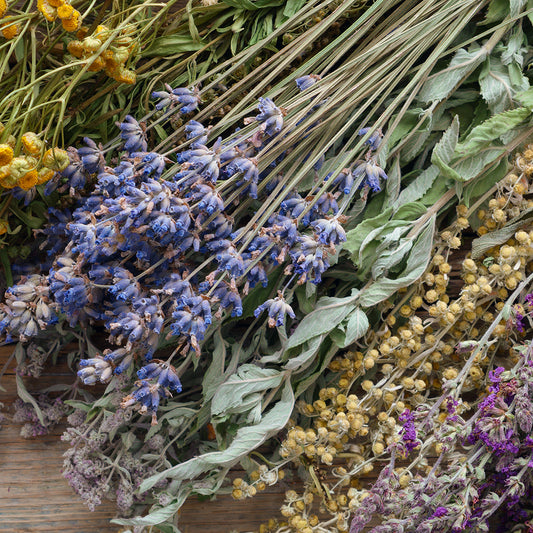My Many Shades of Gray: A Journey
 About ten years ago I was visiting with my mom (left photo). She was 88 at the time. All of a sudden she plucked a hair from my head and said, “You’re too beautiful to let your hair go gray.”
About ten years ago I was visiting with my mom (left photo). She was 88 at the time. All of a sudden she plucked a hair from my head and said, “You’re too beautiful to let your hair go gray.”
Although I had noticed a few gray strands, my hair had always been a mixture of blonde and brown strands and I thought the gray blended in rather well. As the months passed more and more gray sprouted up. So I went into “mad scientist” mode and created an herbal rinse to help enhance the blonde and darken the gray.
It worked rather well (meaning no comments from mom) for about a year until I finally realized that my bangs were not really blondish anymore—they were totally gray.
At that point I decided to just go gray—after all, I was a grandmother now, (but I still felt young!), and besides--why question Mother Nature.
Unfortunately, as the gray strands grew so did the negative comments and I succumbed to the pressure.
Feeling somewhat defeated I trotted off to the drugstore and bought a box of color.
It looked quite natural and I actually liked it! Every six months did the trick for a few years. But then it became every five months, then every four months—you get the idea.
About 18 months ago I decided I had enough. What was I doing? Seriously, I believe so much in natural skin care and I am dumping these chemicals all over my head—for what?
Sadly, our society reveres youth and makes us fearful of aging. The ad for Gray Hair Color Restorer, taken from the National Library of Medicine Digital Collections, is from 1924. I have never been upset about getting older, frankly, it is much better than the alternative.
 My fine lines, wrinkles, and age spots (called freckles in my youth) are a part of my life story. So if I was happy with who I am and comfortable in my own skin, why not be happy with my own hair?
My fine lines, wrinkles, and age spots (called freckles in my youth) are a part of my life story. So if I was happy with who I am and comfortable in my own skin, why not be happy with my own hair?
I would have never thought that what seemed like such a minor issue would become such an emotional challenge.
After making the decision to welcome my gray hair, I began to notice so many confident-looking women wearing gray hair in many shades, styles, and lengths. They did not look old and frumpy, they looked beautiful, radiant, and natural. And basically, that was it. Something deep within me clicked and I felt really good about my decision.
There is something elegant, graceful, and sophisticated about a woman with gray hair who still exudes youthfulness. I realized it is not the gray hair that makes you old—it is your attitude, how you live your life, and how you feel about yourself. I was ready to embrace this new chapter of my life.
So the transitional journey began and it is truly a process that takes patience and perseverance. The transition can last quite a long time depending on your hair length and genetics.
My hair was long, about 4 inches below my shoulders, and I was not ready to cut it short--one drastic change was quite enough. The first few months of the root stripes growing out was the most discouraging time.
Once again the comments came and I must admit I started having second thoughts about my decision. But this time I would not surrender to pressure.
My hair is now shoulder-length. I cut a bit off the ends every month or so and am now about 75% gray!
About Gray Hair
 The hair follicles on our heads number about 100,000.
The hair follicles on our heads number about 100,000.
The number varies with hair color—blondes have the most follicles and redheads the least.
Each of these follicles works autonomously, meaning that each individual hair is on its own individual cycle.
If all of our hair strands were on the same cycle they would shed all at one time and we would be bald until they grew back.
Each hair lasts for two to six years before it falls out and then another takes its place.
The root of every strand of hair is surrounded by a tube of tissue under the skin that is called the hair follicle. Each hair follicle contains a certain number of pigment cells called melanocytes.
These pigment cells constantly make a chemical pigment called melanin that gives the growing shaft of hair its color of brown, blonde, black, red, and anything in between.
 As we get older, the pigment-producing cells in our hair follicles, gradually die and stop producing melanin.
As we get older, the pigment-producing cells in our hair follicles, gradually die and stop producing melanin.
Since the number of melanocytes decreases as we age, the amount of melanin that is produced also decreases.
Since there are fewer melanocytes the strand of hair will no longer contain as much melanin and will become a more transparent color, like gray, silver, or white, as it grows.
Although, gray hair is more noticeable in people with darker hair because it stands out, people with naturally lighter hair are just as likely to go gray.
From the time a person notices a few gray hairs, it may take more than 10 years for all of that person's hair to turn gray. The process of going gray is mainly determined by our genetics.
Pictures of Hair Follicles taken from the Library of Congress website
How To Care For Gray Hair Naturally
I have read so much information over the past year about how to care for my graying locks. The problem is that the whole process—when graying occurs, where it occurs, how long it takes and the resulting colors and textures are genetically determined. Since each of us is unique, the best I can do is to share my experience.
 Texture: There is no doubt that my hair texture is different . . . it feels thinner but not brittle. While there are some coarse, wiry strands, most are actually softer.
Texture: There is no doubt that my hair texture is different . . . it feels thinner but not brittle. While there are some coarse, wiry strands, most are actually softer.
Oiliness: My hair used to be oily—not anymore. As we age, oil glands slow down and produce less sebum, which can result in drier hair. So I now use shampoo bars for normal to dry hair. My hair still loves any bar with coconut milk. I have also found that brushing my scalp helps distribute oils and add shine.
Shampooing: How often I shampoo is a balancing act. While I don’t need to shampoo every day, I find that my hair looks so much better after shampooing. Using the more moisturizing shampoo bars allows me to shampoo often without drying out my hair or scalp.
Manageability: My thin hair was never easy (almost impossible) to style. Actually, the best thing that happened to my hair was the body I got from using shampoo bars.
Although my hair still has body, some of the graying strands can be wiry and unruly. I now use the tiniest bit of hair oil to smooth out those unruly strands. The oil also adds extra body and shine.
Yellowing: At times my silver locks get a yellowish cast. The outer covering, or cuticle, of gray hair, is very porous meaning that it more readily absorbs things like mineral deposits in hard water, chlorine in pools, environmental pollutants, smoke, or styling product residue which may give gray hair a yellowish tint.
I have found two things that help.
1. Apple Cider Vinegar: I make a diluted rinse using about 1 to 2 teaspoons of apple cider vinegar to 1 quart of water. An ACV helps remove the residue in the hair that can cause yellowing. Since gray hair tends to be dryer, this recipe is more dilute.
A simple ACV rinse is easy to make. Read "Make Your Own Apple Cider Vinegar Rinse."
You can also click here to purchase Chagrin Valley’s certified organic Apple Cider Vinegar Rinses.
 2. Botanical Infusion Rinse: If you think back to art class we learned about the color wheel and color theory. Complementary colors lie opposite one another on the color wheel and tend to neutralize each other.
2. Botanical Infusion Rinse: If you think back to art class we learned about the color wheel and color theory. Complementary colors lie opposite one another on the color wheel and tend to neutralize each other.
Since blue is a color complement to orange and purple is a color complement to yellow, a rinse made with an infusion of purple or blue botanicals can help minimize the yellow or brassy colors often seen in gray hair.
For my botanical rinse, I usually use dried cornflower, Centaurea cyanus, but in the summer I will often use blooms from other purplish-blue blooms, like purple coneflower, growing in my garden.
Simply make a strong tea (infusion) of purple or blue flowers with hot water. Allow the flowers steep in the water until you get a nice rich color. The more concentrated the infusion, the stronger the color. I use this rinse after shampooing as needed. Sometimes I use it as the water to dilute my apple cider vinegar rinse.
Going gray may not be for everyone. The most important thing to remember is that it is your life, your hair, and your choice. Don't allow yourself to be bullied by the opinions of others. Just keep your goal in mind and remember if you don't like it you can always go back to coloring.
Now when people comment about my grey hair I reply with a confident smile, "It is my hair, and I love it”!
A few days ago my mom, now 98, looked at me, pushed my bangs away from my forehead and said, “you look so beautiful with gray hair.”
Have you gone gray? Are you thinking about it? Please share your experience!


